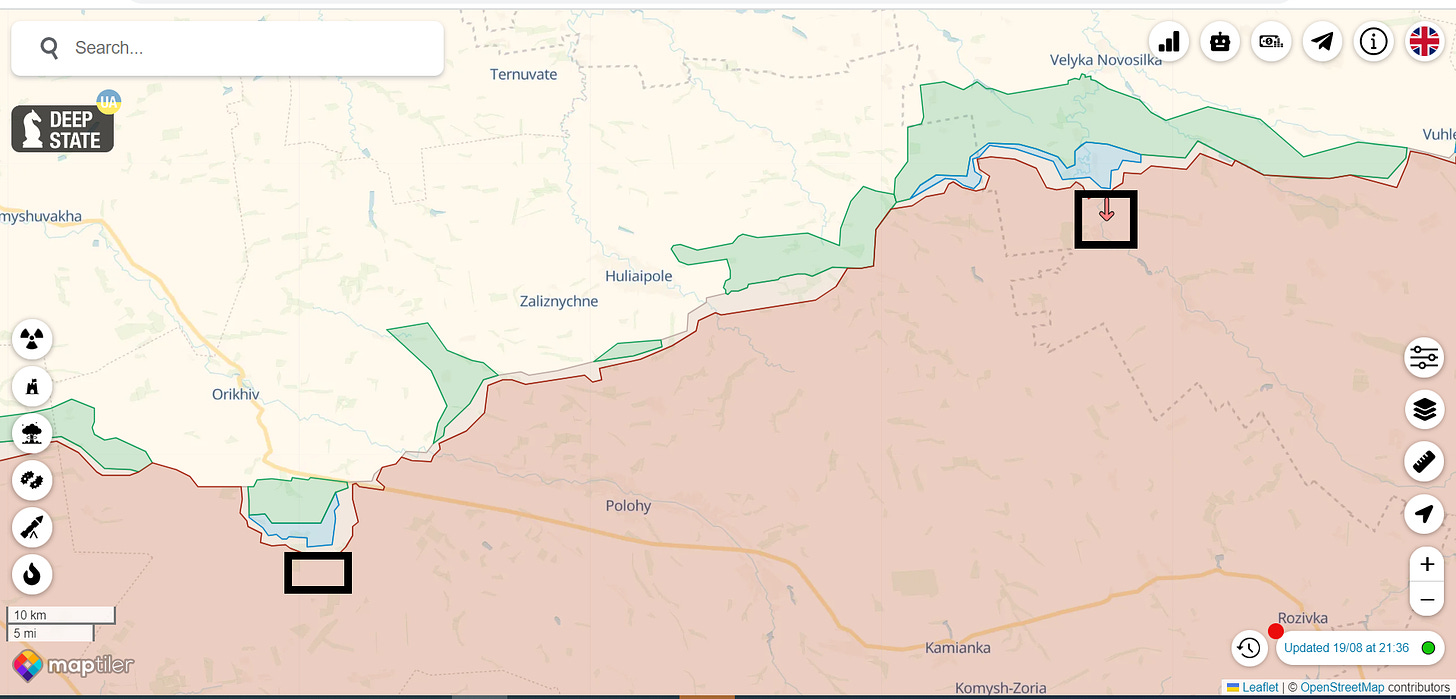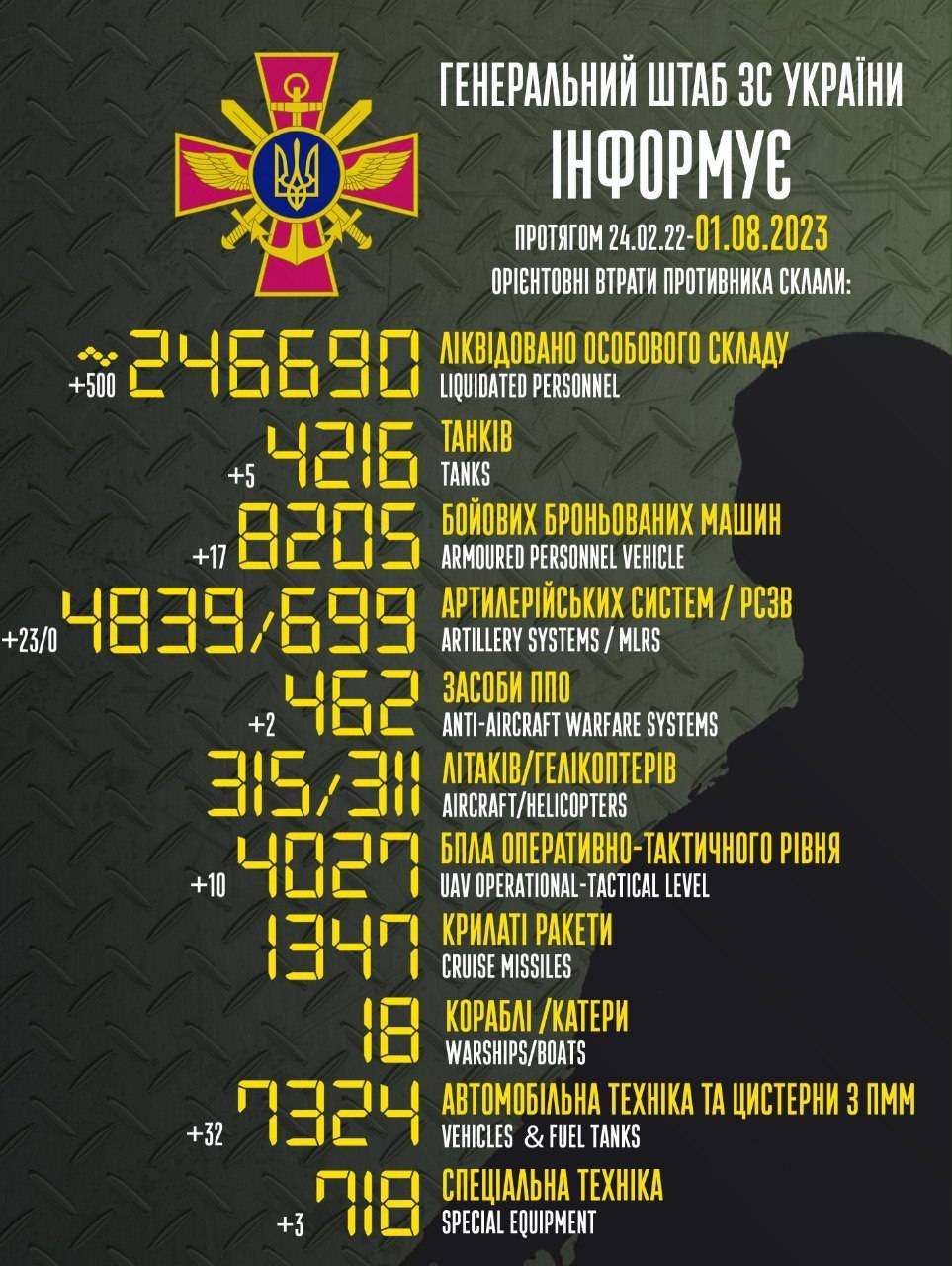The Ukrainians' persistent degradation of Russian supplies, logistics, artillery and command centers - combined with grinding attacks across the front - is having a notable impact on Russian forces' ability to defend their lines.
Ukraine's strategy is having a demonstrable effect on Russian artillery - their primary strategic weapon - as well as on their ability to marshal reinforcements to respond to Ukrainian assaults. JL
Phillips O'Brien reports in his substack:
The Ukrainians seem to be having success going about their business - the Ukrainians made advances while destroying Russian artillery. In fewer than 3 weeks, the Ukrainians have destroyed 7% of Russian artillery (available) since February 24, 2022. That's a high percentage. The relative balance indicates Ukrainian priorities: that the Ukrainians' campaign is creating a major imbalance in the artillery destruction rate (in their favor). The Ukrainians are pressing forward with their best equipment—they are just not being stupid about it. Grinding destruction doesnt get much coverage, we (are) seeing real evidence that what it's doing is working.I had to start with the anonymous US sources trying to shift blame for the slow pace of the Ukrainian advances, as its been the big story of the last few days. Of course, remember, these are just stories, the was itself grinds on much as it has been.
Though the counteroffensive continued to grind on much as it has (and the Ukrainians made some advances while destroying Russian artillery) the whole tenor of discussion about the counteroffensive really changed near the end of the week when this story appeared in the Washington Post.
https://www.washingtonpost.com/national-security/2023/08/17/ukraine-counteroffensive-melitopol/
On the one hand, it was surprising that one story received so much coverage. Its key sources were all anonymous for one thing. However that was not all. The piece was wildly illogical and showed that the sources either have no understanding of how war works, or deliberately obfuscated to try and justify themselves. I will point out three of the weird problems with the piece—starting from the very beginning.
The story opened with this paragraph.
“The U.S. intelligence community assesses that Ukraine’s counteroffensive will fail to reach the key southeastern city of Melitopol, people familiar with the classified forecast told The Washington Post, a finding that, should it prove correct, would mean Kyiv won’t fulfill its principal objective of severing Russia’s land bridge to Crimea in this year’s push.”
The story then provided a map which actually shows that Ukraine doesnt need to reach Melitopol to functionally divide Russian forces on the Kherson/Dnipro front from those in the east.
All the Ukrainians need to do is deny the Russians all road and rail access into Kherson from anywhere in except Crimea, and they would have actually done the job of dividing the forces. At that point, as the map makes clear, all they really need to do is approach Melitopol to achieve that. The roads go in and out of Melitopol and what Ukraine needs to be able to do is exert fire control over those roads. It actually doesnt nee to occupy the city. Whats even weirder, is the story actually assumes the Ukrainians could get very close to Melitopol—remaining only ‘several miles’ outside the city. If Ukraine actually gets within several miles of Melitopol, I can assure you that the counteroffensive will going fine. The actual quote in the article about that is excerpted below.
Ukraine’s forces, which are pushing toward Melitopol from the town of Robotyne more than 50 miles away, will remain several miles outside of the city, U.S. officials said.
Having started with a confused and non-sensical criticism, the article pivoted to the most pathetic example of blaming the Ukrainians that I have seen in a major piece. Why wont the Ukrainians reach Melitopol? Well the piece first talks about the depth of Russian defenses—which Im sure anyone reading this substack will know about. The Ukrainians have an extremely difficult task in trying to advance into defensive weaponry without air supremacy. However, instead of accepting that reality (amazingly the article never mentions air power once), the anonymous sources blame the Ukrainians for not continuing to bash their forces against Russians defenses. This really is weird, saying the Ukrainian reluctance to accept casualties somehow kept them from achieving a breakthrough. The paragraphs of convuluted reasoning seem to conclude because Ukraine had a success in a war game, it would have it on the battlefield.
Joint war games conducted by the U.S., British and Ukrainian militaries anticipated such losses but envisioned Kyiv accepting the casualties as the cost of piercing through Russia’s main defensive line, said U.S. and Western officials.
But Ukraine chose to stem the losses on the battlefield and switch to a tactic of relying on smaller units to push forward across different areas of the front. That resulted in Ukraine making incremental gains in different pockets over the summer.
Kyiv has recently dedicated more reserves to the front, including Stryker and Challenger units, but has yet to break through Russia’s main defensive line.
As the article sneaks in at the end, the Ukrainians are trying to press forward with their best equipment—they are just not being stupid about it. And even though they are using some of their best equipment, its still a struggle to breakthrough many weeks after the campaign to weaken Russian defenses started.
The piece might have mentioned that in this war we have not seen a single breakthrough/exploitation against a prepared enemy position
Then we have the piece de la resistance of the article—the greatest buck passing Ive seen, which is so egregious that I cant even blame it on stupidity. It is probably willfull mendacity. Having bemoaned the slow Ukrainian advance, and blamed the Ukrainians for not banging their heads against a wall, the article claims that having given Ukraine greater range capacity months earlier would not have helped. ATACMS and F-16s, what good are they, the article claims.
U.S. officials reject criticisms that F-16 fighter jets or longer-range missile systems such as ATACMS would have resulted in a different outcome. “The problem remains piercing Russia’s main defensive line, and there’s no evidence these systems would’ve been a panacea,” a senior administration official said.
This is extraordinary. This was has reinforced the salient point of all wars, that supply and logistics have a massive influence on what occurs on the front line. If Ukraine had been given greater range capacity months earlier, they could have hammered Russians logistics up and down Russian occupied Ukraine, from Crimea to Mariupol. Indeed, to escape HIMARS, the Russians have moved their depots into these safer regions.
This idea that battles are decided just when forces meet on the battlefield is so primitive and wrong-headed that I cant believe that the person made it seriously (you can see why they wanted to remain anonymous), or more, that people seem to be accepting it on face value.
So this article was deeply flawed for a number of reasons.
garbles the Melitipol question enormously
implies there would have been a breakthrough if Ukraine had continued hammering Russian defenses (after telling us that Russian defenses were really strong
Conveniently ignores air power, as if one of the most important components of modern war doesnt matter.
Says giving Ukraine greater range capacity months ago, would not affect the battlefield today—which is preposterous.
Things Grind On, Small Advances, Artillery Destruction, and F-16s
It was fascinating to see how this one story changed a narrative, because what was going on in the battlefield showed the continuation of the Ukrainian campaign to degrade Russian power, push the Russians back slowly, and lay the groundwork (hopefully) for future advances. Indeed up through Wednesday the Ukrainians seem to be having some success going about their business.
They liberated the village of Urozhaine (the black box on the right) and pushed into Robotyne (box on left). These are hardly world shattering advances, but they show that the momentum remains with Ukraine. Even as of this morning, Russian reports are of Ukrainian advances around Robotyne.
https://twitter.com/NOELreports/status/1693165172016222385?s=20
Of course, terrain is only part of the story. The Ukrainians are continuing their campaign against Russian artillery, and their claims are that it is still high priority. The claims from this morning are indicative.
https://twitter.com/GeneralStaffUA/status/1693145776694710277?s=20
Not only were 33 new systems destroyed, since August 1, the Ukrainians claim to have destroyed 424 artillery and MLRS systems together (see claim below)
So in fewer than 3 weeks, the Ukrainians have claimed to destroyed more than 7% of Russian destruction since February 24, 2022. Thats an extremely high relatively high percentage. While Im not saying these are definitely right, the relative balance indicates Ukrainian priorities. And there is some strong visual evidence these days that the Ukrainians campaign is creating a major imbalance in the artillery destruction rate (in their favor).
Such grinding destruction doesnt get much coverage, but it tells us more about the course of the war than anonymous sources.
Finally, plans for providng Ukraine with F-16s seem to have been picked up a place.
























0 comments:
Post a Comment